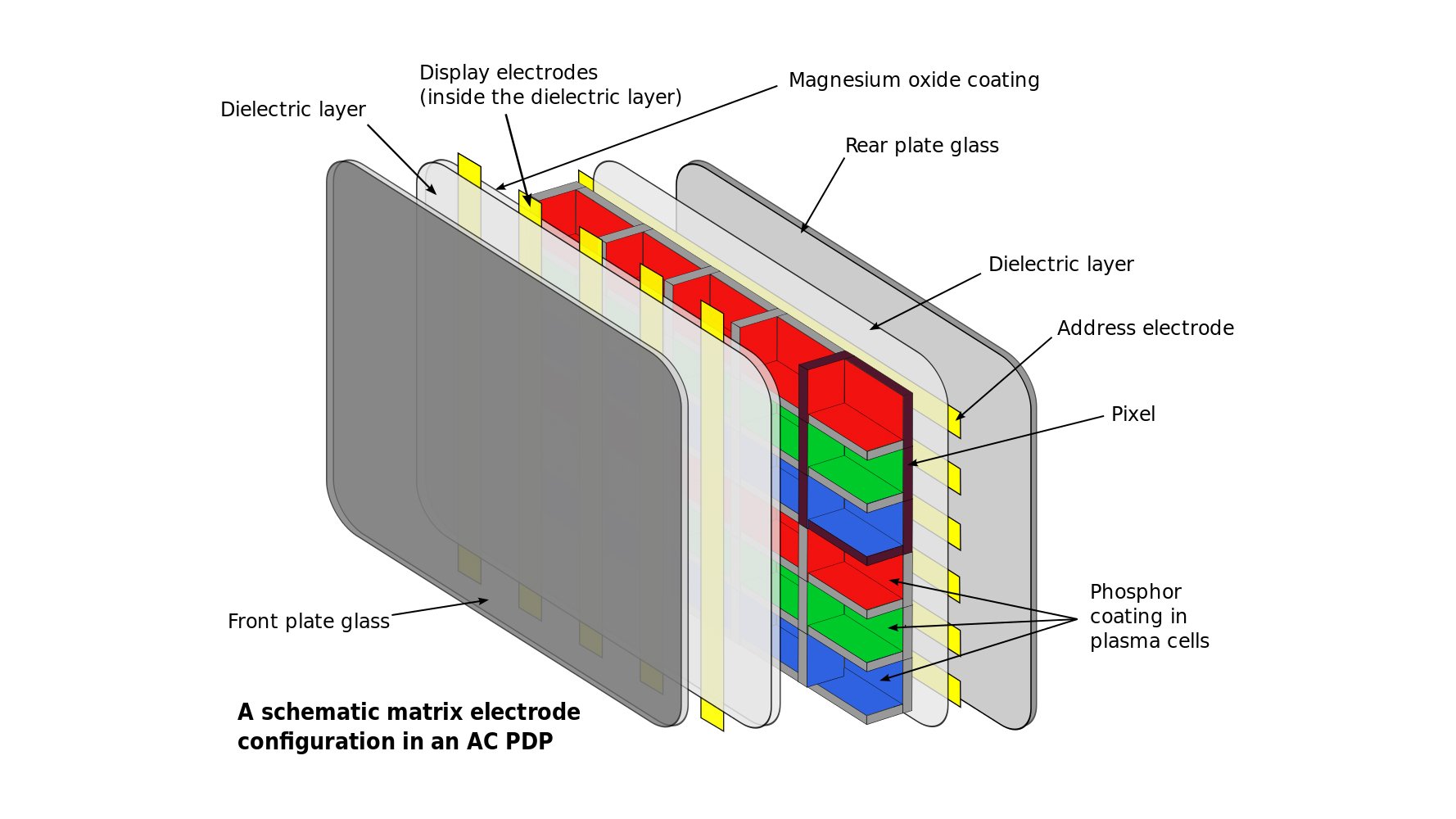
You don't hear much about plasma TVs these days, and for good reason: no one has made them for several years. But for TV technology that was once the pinnacle of picture quality, where have plasma TVs gone? Writing about popular technology that has been around and gone is like writing a love letter to an ex. You remember the reasons why you loved them and also how they bothered you. It is an exercise of purification of the soul. But what do we remember when we talk about plasma TVs? The technology that made flat panel displays a daily reality for you and me was born in a humble laboratory at the University of Illinois. The potential of what began as an academic experiment to create an educational computer display became very apparent to TV manufacturers, who struggled to find a realistic solution to replace bulky CRT (cathode ray tube) televisions. Plasma screens have millions of cells, filled with gas, perfectly positioned between two sheets of glass. When charged with electricity, the cells, or pixels, light up to form the image. This charged gas is called plasma, hence the name screens. CRT models, on the other hand, feature a single tube that defines the size of the screen. The switch to plasma technology and the use of millions of cells has made it much easier to expand the size of screens, while also making them equally thin, much thinner than normal CRT equipment. Also, the higher definition and refresh rate resulted in much better image quality. To understand the allure of plasma and how it has managed to capture hearts and living rooms, you have to look beyond the pretty screen and into the heart of the technology behind it.
- Next-Gen TVs: The OLED, Micro LED and Holographic TVs of the Future
Plasma TVs: How Do They Really Work?

(Image credit: Wikipedia / Jari Laamanen) Think of a plasma TV as a neon light. It is based on an emissive technology that uses plasma to excite phosphors and emit light. “Glass is comparable to window glass, unlike LCD. There are horizontal and vertical electrode grids and an array of phosphors. The connection between the two is scanned, triggering the discharge at the intersection and causing the phosphor to glow,” says analyst Paul Gray, who leads television research at Omdia, a global company that provides analytics across the technology ecosystem. . "The phosphor side is similar to CRT, while the plasma is a glow discharge like a neon lamp." But the genesis of technology had nothing to do with the entertainment industry. Larry F Weber, a member of the Institute of Electrical and Electronics Engineers, wrote the following in IEEE Transactions on Plasma Science: “As with any invention, it all started with a need. In this case, it was the need for a high-quality display for computer-assisted instruction. The University of Illinois started a project in 1960 called PLATO (Programmed Logic for Automatic Teaching Operations) to conduct research on the use of computers for education... The Plasma Display Panel (PDP) was invented by Professor Donald L Bitzer, Professor H Gene Slottow, and their graduate student Robert H Wilson in 1964 to fill the need for a complete graphical display for the PLATO system. " Technology has evolved rapidly, literally from laboratory glassware to the best television screens, in a very short period of time.
Plasma TVs: the beginnings

(Image credit: IEEE Transactions on Plasma Science) However, as would be the case with any technology product destined for the consumer market, there has been a long period of low-volume, high-cost production. The first manufacturer to get into mass production of plasma was Fujitsu, which made a 42-inch screen in 1997. The screen sold for $20,000 (about $15,000 / AU$26,000), according to the San Francisco Business Times. . . Philips and Pioneer followed suit, with other manufacturers piling in soon after. “The starters were Fujitsu and Panasonic, but NEC, Pioneer, Samsung, LGE and Chunghwa (CPT) made the displays,” says Gray. “Most of the brands had plasma in their lines. It's important to remember that in the early 2000s, the PDP was the leader in large-screen TVs, such as the 42-inch models, and there were serious questions about whether the 42-inch LCD was economically viable. Sony and Sharp have even worked on a hybrid technology called PALC, plasma steered liquid crystal. "It was the first time that a large television had been available in a form that could be mounted on the wall. This was a huge leap from furniture CRT televisions that were boxy and heavy, yet sturdy. Remember also that it was a strange world where the small and large screens (LCD and projection respectively) were flat, but those in the middle (14 to 37 inches) were curved.
Plasma TVs: Picture Quality

(Image credit: IEEE Transactions on Plasma Science) Plasma TVs had come a long way since their first incarnation. It continued to dominate the mainstream TV display market and delivered one of the best viewing experiences available. Plasma TVs had panels that lit small gas cells (xenon and neon) between two glass plates, delivering very bright and sharp images even on a large screen area, according to Samsung, which was one of the leading manufacturers of plasma TVs. plasma. The displays contain phosphors that create the image on the screen, are self-illuminating and do not require a backlight. The technology meant that large screens (typically 42 to 63 inches) "offer high contrast ratios, beautifully saturated colours, and allow for wide viewing angles, meaning every seat in the house is great," according to Samsung, while it worked well in dimly lit rooms, which is great for watching movies.” It could also “track fast-moving images without motion blur,” making the plasma “great for watching action-packed sports or playing video games.” The sharpness of the visual details is amazing.” However, there were some drawbacks. Plasma used more electricity than LCD (Panasonic used at about parity, and plasma power consumption was highly dependent on the amount of light in the video content). It was heavier, with a lot more power electronics in each set. Ce n'était pas aussi brilliant, ce qui signifie que pour en profiter pleinement, vous deviez vraiment aimer votre expérience de visionnage de style cinéma faibly éclairée - ce qui n'était pas un inconvenient si vous n'étiez pas fan de la télé de day. Wear and tear was also an issue, especially for avid gamers.
The plasma boom and the new neighborhood kids

(Image credit: IEEE Transactions on Plasma Science) In 2005, six million units of plasma were shipped around the world each year, according to Omdia data. "Business peaked at 18,4 million in 2010," says Gray. But then other technologies began to catch up. LCD screens were clearer and brighter. They used much less power and performed better in daylight. “Basically, the fundamental problem was the pace of innovation,” Gray says. “Plasma had to counteract the LCD industry, which had more players working on development. It faced a level of R&D that was unprofitable or alternatively slowly lagging behind. Samsung and LG were only in the PDP market as an insurance policy, while the Japanese didn't want to place big bets. To be fair, they acted rationally: while Korea Inc made its money back on LCD, Taiwan Inc has only broken even, and China Inc's chances of achieving a positive return on its LCD investment are slim.
The end of plasma televisions
The plasma honeymoon didn't last, then, and there were a few basic factors that had a serious impact on sales, including one of the common criticisms leveled at OLED, namely low light. “Plasma was not as bright as LCD. Especially in US retailers, the TV area was well lit and the PDP looked washed out,” Gray says. “Plasma, like all broadcast displays, struggled with fine pixel densities. Only Panasonic managed to make a 1080-inch 42p, and even then it wasn't a great product commercially. Manufacturing performance would have been poor. Ultimately, the LCD had massive manufacturability and the advantage of scale. The PDP was not unique enough. As manufacturers began to have large losses, they began to phase out plasma. Pioneer has ceased production of its popular Kuro displays. When Panasonic announced that it would no longer make plasma displays, everyone knew the end was near. LG and Samsung followed suit soon after. And just like that, the plasma light went out. Today's best LG CX OLED deals






